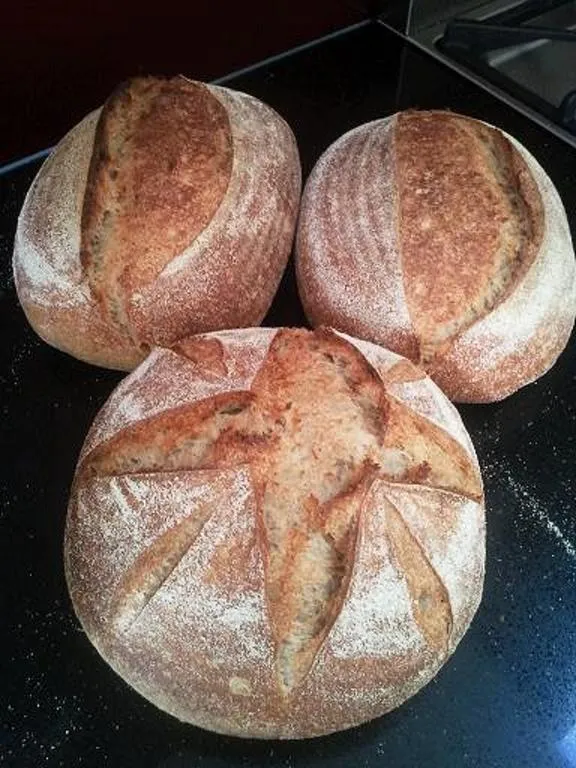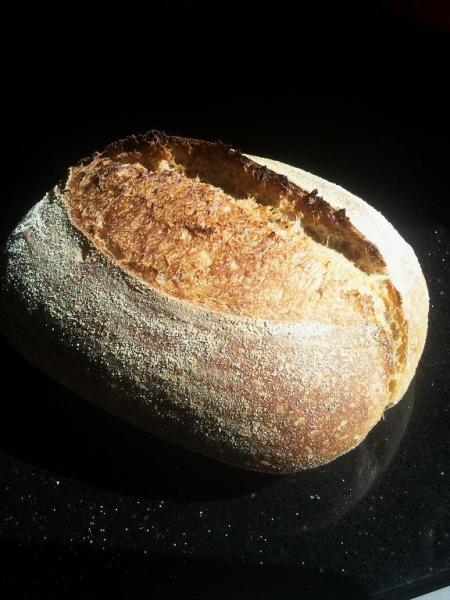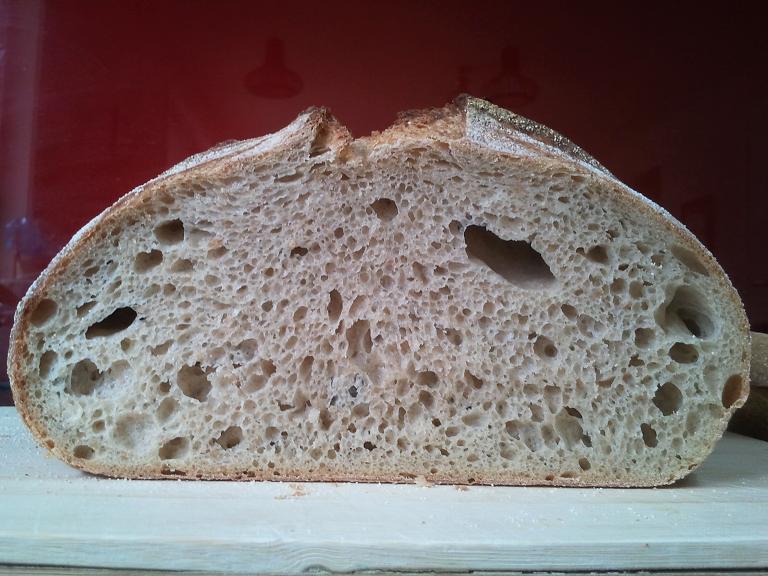
Hi everyone!
It has been a while since my last visit to TFL. I have been quite sick and bedridden for a few weeks. My sister has to take care of Blossom (my seed starter) until I feel better. We miss her so much! I was so happy to have her home last week, healthy and happy.
Summer is around the corner in Melbourne but the weather is still quite cold. I decided to bake a few country loaves today. Two loaves are to give away as thank you gifts to our good friends who have helped out and sent me so much food.
When I was sitting down to work out the amount of levain for 3 loaves, I suddenly remembered what I read not long ago in Graham Prichard’s blog of sourdough.com. This is one of Graham’s methods at the Companion Bakery in Tasmania. A stiff starter is built at 15C for 20 hours then turn into a warm liquid starter in the second build. The liquid starter should be kept at 28C to 33C and it is ready to use in around 2 to 4 hours. The idea of this method is essentially to give the starter a warm and wet condition to favor the lactic acid production. I decided to give his method a go this time to see if my country bread to taste differently from my last loaves.
If you like to read more, here is the link: http://sourdough.com/blog/companion-bakery-tasmania-how-we-make-sourdough

Here is my formula:
Country Bread
3 loaves (about 900g each)
Levain 17% preferment flour
1st build @ 60% hydration
50g white starter @ 100% hydration
50g whole wheat flour
20g cold water
Mix all together and leave for 12 hours at room temperature of 18oC
2nd build @ 125% hydration
120g stiff starter @ 60% hydration
125g whole wheat flour
230g warm water
Add water slowly to the starter ball and stir until the mixture is smooth. Add whole wheat flour and stir well together. Make sure the starter is at around 28C to 30C and should be matured in about 2 hours to 4 hours.
When I started my second build, my liquid starter was at 30C and I couldn’t maintain this temperature as my room temperature at the time was only 16C. It took 10 hours to mature.
Final Dough @ 78% hydration
475g levain @ 125% hydration
75g organic whole rye flour
50g organic whole wheat flour
150g organic whole spelt flour
1025g Australia’s Laucke organic plain flour (11.5% protein)
900g cold water
15g salt
I mixed the flours and water until all well hydrated. The autolysis period was 10 hours at room temperature of 16oC.
Levain and salt were added in to the autolyse. It was quite messy when mixing a liquid levain into the autolyse by hand. With a large dough to mix by hand this time and since I don’t use slap-and-fold method, I thought I better give it a few extra letter folds. Room temperature was 16C so bulk fermentation was 6 hours in total. There were 5 double-letter folds every 45 minutes. The dough was divided, shaped and final proof for another two hours then retarded for 18 hours. I intended to bake those loaves off at 6am in this morning on but I slept in until 8!
The oven was preheated to 250C with the Dutch ovens. I baked straight from the fridge then immediately I turned the oven down to 230C when all loaded into the oven. It was 25 minutes with the lid on and another 20 minutes with the lid off.
Lucky there were no harm done after 18 hours in the fridge …. Phew!

Crumb of the boule
After a few hours of cooling, here is the crumb of the boule. The crust is sweet and crunchy, the crumb is tender and moist, nutty and complex. There are definitely acidic notes in the background but it is a very soft tang. I think may be the dough had a bit long retarding period.
In all and all, I started to understand better Jeffrey Hamelman’s sourdough recipes in his Bread book after this bake. This time I couldn’t maintain the final build of starter in a warmer environment as Graham suggested, I definitely will try this method again in summer time to see whether the bread flavour is different. But for now, I think I should be off and do some catch-up readings here.
It is great to be able to bake again. Hope you all are well and happy baking.
Annie
- annie the chef's Blog
- Log in or register to post comments
Hi Annie...I'm sorry to hear you were so sick and I'm happy you seem to be doing better. I know baking always makes me feel whole again.
These are some beautiful loaves to warm your heart and nourish your soul :).
Thanks for sharing and welcome back.
Regards,
Ian
I always feel blessed to be able to bake, cook and enjoy beautiful food everyday.I am thankful that I was sick for a short while.
Cheers,
Annie
Very nice, Annie! Glad to hear you are feeling well again.
It's good to be back here again.
Annie
The crumb looks just perfect!
The starter refreshment you describe is somewhat similar to what I often do, but different. Starting with starter that has not been fed for a few days and kept in the fridge, I will usually give a 100% hydration first refreshment to get the yeast up, then a 50% hydration build to use for the final dough. Both are usually fermented at room temperature. The second build typically triples in 6-8 hours.
I need to think about a liquid 2nd build fermented at a higher temperature. I can do it with my proofing box easily.
I'm sorry you were ill, but happy you are recovered. Stay well!
David
I normally do build my levain the same as your method. I found that Graham Pritchard's method was quite intriguing. I think Andy (ananda) did use pancake batter like starter built in a warm environment in some of his bakes but I don't remember which ones.
I used to wonder the purpose of using 125% hydration starter for Hamelman's Vermont Sourdough and his stiff starter for Pain au Levain. Both loaves to me have very similar crust, crumb and flavour. Now after almost a year of reading and baking sourdough breads, I'm sort of starting to understand the recipes.
Please let me know the outcome if you are going to do experiment with your proofing box.
Cheers,
Annie
baking will put some color back in those cheeks. You bread looks perfect insie adn out and I love your clay bakers too. I love the recipe for this bread too. A nice multi-grain,with Whole; spelt, rye and wheat is my favorite - like the ones I baked today only yours came out better.
Like David, take a small amount of stiff rye starter (10-15g) out of the fridge, where it has not been fed for 3 weeks or more, build it to 100% hydration on the first 2 hour build and also 100% on the 2nd build (when it doubles) and then knock it back to 80% hydration on the 3rd build (throwing nothing away) Then refrigerate it again for 24 hours after it rises 25% after the 3rd build (about an hour) - You won't have to worry about not having enough tang with that.
Happy baking
Like you, I did try not to discard any unused starter and calculate to build the levain just enough for the loaves and 50g seed starter@ 100% hydration to keep. I think I should change to keep stiff seed starter so it lasts longer until next feed.
I love baking in those clay pots. They are saving me from cleaning the mess in the oven if I am to use the stone after baking. All I have to do is shaking and brush off all dusting semolina in the pots and Bob's your uncle! I am now living a life without the kitchenhands you see ... I miss them. (sigh...)
Thank you so much for your kind words.
Annie
Hi Annie,
Welcome back!
These are beautiful but I especially LOVE the scoring on your boule. When I attempt doing that I can't get the smaller scoring slashes to stay where I want them and they end up bursting into the center 'star'. By looking at yours I think I know why they do that now so I am excited to try out my new 'theory'.
Thanks so much for including the photos!
Take Care,
Janet
It happened to me when I first started to bake sourdough bread. I think my loaves in the past could have been under-proofed, then I thought may be I didn't shape it right. I am now practicing shaping boule by using my both hands to drag the dough towards me a few times until I feel the tension on the surface of the dough. The seam disappeared when it is fully proofed and the loaf had a very smooth bottom after bake. Scorings on the loaf seemed to stay where I wanted them too.
Thank you so much for your kind words.
Best wishes,
Annie
Very nice loaves, they look great.
Cheers,
Annie